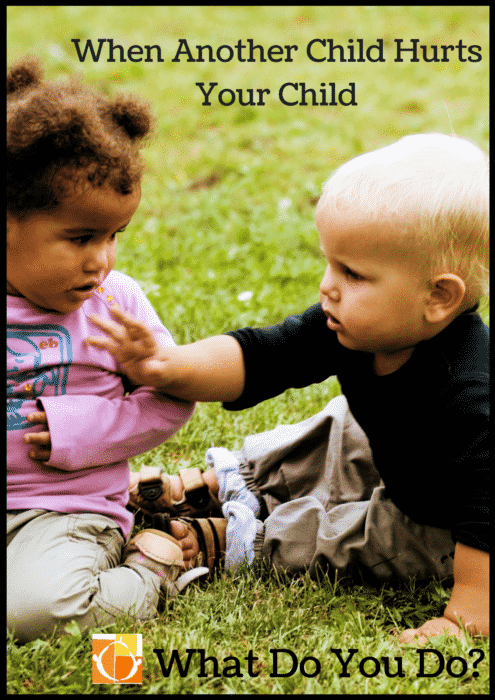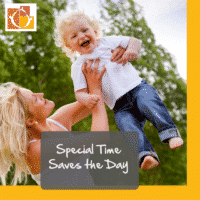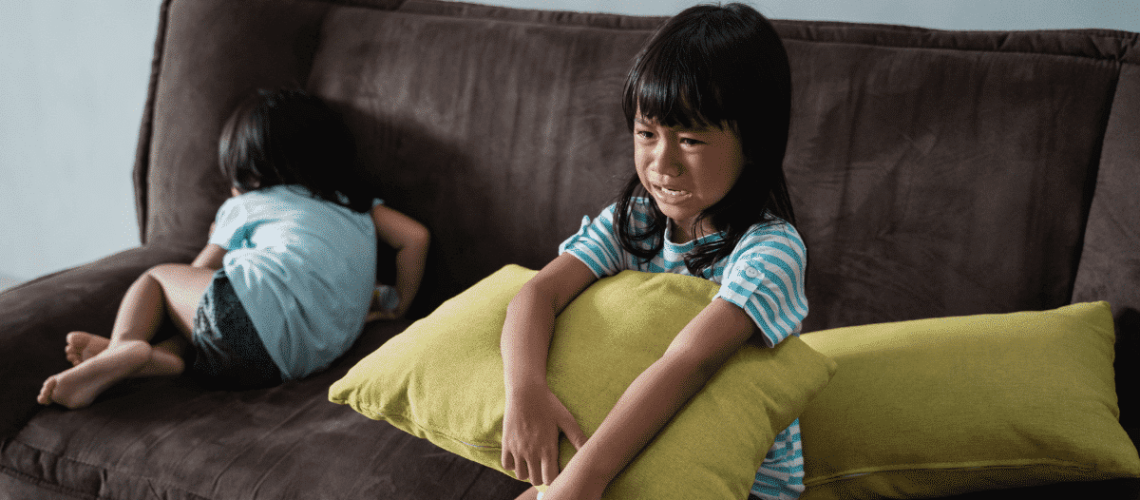Imagine you’re taking a break at the park, while your child experiments with ways to have fun on the swing. She’s swinging on her tummy when another child whom you don’t know approaches her and says loudly, “That’s my swing!” Startled, your child just looks, frozen in place. The demanding child walks up and kicks your child in the leg. No one saw it coming. Your child bursts into tears, and you are horrified!
 Most articles on aggression focus on dealing with the aggressor. But in every aggressor/victim encounter, both children need help. Perhaps you would welcome a little help too, given the feelings that can flare when another child hurts your child. There are several Hand in Hand resources that focus on how to help the aggressor, and I’ve cited one at the end of this article. For now, let’s take a look at how to help a child who’s been hurt. I’ll also outline how to prepare ourselves, so our own flash of upset doesn’t do further damage in these already throbbing situations.
Most articles on aggression focus on dealing with the aggressor. But in every aggressor/victim encounter, both children need help. Perhaps you would welcome a little help too, given the feelings that can flare when another child hurts your child. There are several Hand in Hand resources that focus on how to help the aggressor, and I’ve cited one at the end of this article. For now, let’s take a look at how to help a child who’s been hurt. I’ll also outline how to prepare ourselves, so our own flash of upset doesn’t do further damage in these already throbbing situations.
There are a few understandings that can guide our actions as parents. You can use them like a compass. Whatever you try with your child, these insights will help you intervene in ways that move both children forward toward a sturdier friendship.
A threatened, insulted, or hurt child will heal well if you can listen.
When our child falls and skins her knee, we tend to be able to hang on to the thought that she will heal. But when another child hurts her, the pangs we feel go deep. It feels personal. We fear some kind of permanent damage to our child’s confidence.
But in fact, your child knows how to heal from any aggressive act. The healing process that benefits both her body and her confidence is built right in. She begins to cry. She might tremble. She might even stand her ground and protest. If you move in close to support her, her feelings will probably intensify. She’s likely to cry a good long while. She’s smart, this child of yours. Crying with good support heals the hurt!
So put your arm around her and offer her eye contact, without a lot of talk, so she can focus on exactly what happened to her. As she does, she’ll cry the hurt away. Don’t hurry her. Listen. Murmur a bit of reassurance here and there, but let her feelings be the focus for your attention. Let her cry until the thought of what happened doesn’t bother her any longer. That’s the point at which her confidence will bounce back, perhaps even increase, because you were there. You helped. The feeling of insult and the pain will engulf her mind as she cries, but when she’s finished, their importance will fade. She can go back to playing. She’s over it. Her tears help her process what happened to her and help dissolve the pain and the insult. Your loving attention restores her sense that she is safe and cared for.
The song from the 70’s, “It’s All Right to Cry” sums it up well:
It’s all right to cry
Crying gets the sad out of you…
Raindrops from your eyes
Washing all the mad out of you
Raindrops from your eyes
It’s gonna make you feel better
In our work over the years, we’ve found that children whose parents or caregivers allow them to fully process the feelings that come from an injury or an insult are able to bounce back well. The sting of the other child’s attack doesn’t follow them for days or weeks. They come out of the situation stronger because of the healing action of crying and trembling, and because of the care their listener poured into them.
Of course, if there’s a wound that needs to be cleaned or dressed, do it! But unless it’s a real emergency, you might try listening first. At the moment of insult, your child feels overwhelmed, and she cries in order to restore her emotional equilibrium. See what you can do to keep your hurry and scurry, your ice and your band aids, out of the mix at first. If you let her express her feelings until she reaches a calm state again, you can then engage her in wound treatment decisions. Giving her some say about what happens to her body is a helpful step away from the victim role.
Reassure your child that people are good at heart.
It’s not helpful for children, or for us, to be taught that others are bad. It disempowers us. If others are seen as “bad,” then they have a condition we can’t help them with. We have to defend ourselves against a force that we can’t influence. Here’s a more empowering perspective: when people ache for safety, for love, or for the attention they need in order to feel connected, they sometimes lash out because they’re frightened. They hurt inside. In short, hurt people hurt people.
This perspective allows for the possibility that someone can figure out a way to help that hurt child to connect more securely with others. You, the parent in a playground situation, may have no solutions at the moment, but if you say, “I’m sure she must be feeling bad today, or she wouldn’t have done that to you,” your child has an explanation that’s accurate, and her only task is to shed her own bad feelings. She doesn’t have to deal with a sense that these situations are beyond all understanding and help.
So let your child know, “You didn’t do anything wrong. That child didn’t get the help she needed today. She had some big feelings, and no one noticed.” There is no enemy. Your child can concentrate on healing her hurt, plain and simple.
We grownups are responsible for children’s safety.
Some children whose needs aren’t fully met can get caught in behavior patterns that lead to frequent victimization of a younger child. Parents need a pathway out of this thicket of child-on-child aggression. And educators need this too, so that certain youngsters aren’t allowed to run roughshod over others time and time again.
With good, consistent support over time, a younger child who is being targeted repeatedly can work her way out of the feelings of helplessness that get triggered every time an older child threatens. She can stand up for herself. But to develop that ability, a child needs to be reasonably free of current threats to her safety.
It’s the grownups’ job to keep young children safe. When a child carries aggressive tendencies, the adults around her can learn to anticipate difficulties and to offer effective limits before anyone is harmed. For this, careful planning makes all the difference.
Frequent short doses of Special Time for the aggressor, dedicated shadowing of that child during hot-button activities or times of day, and policies that keep the child from entering situations she can’t handle, can keep down the number of out-of-control incidents. Warmly applied limits, like, “Emma, I can only let you on the slide when all the other children are off it. You can come wait here, on my lap,” are vital.
Finally, Staylistening with an aggressive child when her upsets arise is vital. Confident adult support and listening will allow a child to offload the outsized feelings of fear that make her a threat to other children. Supporting her through these big emotional episodes will, in the end, help her to feel safer and more connected to those kind adults who set those limits, then listen so she can heal.
Empower a less confident child, one small step at a time.
If children are listened to at times of pain and difficulty, they will eventually find ways to hold their ground in situations that would challenge even an adult. You, who love your child, have the power to build her confidence over time, even if she’s hardly able to lift a finger on her own behalf right now.
Start small. Resilience and interpersonal skill build slowly. For example, when you see that another child has grabbed your child’s favorite cup, and she’s crying hard, you don't have to say much, just listen, and approach we simply call Staylistening. Care. This addresses first roadblock to confidence—it supports her to dissolve a heap of sad, mad feelings.
When she’s finished crying, ask her if she wants to do one small thing in the direction of taking charge. If she has been sitting there, bereft of her cup, ask her if she wants to get up and find it. “Shall I go with you to see who has it?” No big deal here. No confronting the child who took it. At first, don’t expect her to say anything to anyone! Just offer the thought of getting up to go see what happened to her cup.
If a child feels deeply helpless, the thought of taking any kind of initiative will bring up another layer of feelings that are in her way of acting confidently. She’s likely to collapse, saying she can’t or she won’t get up. Listen if you can. This is the good stuff. Releasing these hard-core feelings of helplessness will lead to some real gains in her ability to play more confidently with others.
You don’t need to force her to take initiative. Just keep suggesting it now and then in a relaxed way. Allow for the tears and fears that the idea brings up. She does not have to be able to follow through on your suggestion for your listening to be effective. Every moment she cries about how she can’t or won’t take initiative is a step toward shedding feelings of helplessness. When she’s finished crying, she’ll be able to give you an answer from her centered self. If that answer is, “No, I want a different cup now. I need a drink of water,” then help her find another cup. The issue is over for now. You’ll be called upon to help her drain more of these feelings another day.
When she feels sturdy enough to stand up and find her cup, you can ask if she’s ready for the next step toward taking charge. “Do you want me to go with you to find Joey?” When that’s possible, then, “Do you want to say something to Joey? Again, listen to “I can’t,” “I don’t want to,” “He doesn’t like me,” “He won’t listen,” “You do it, not me!” or, “I want to go home.” Eventually, she’ll have shed enough feelings of “I can’t” to stand firm with friends or siblings when they transgress.
Empowering a child caught in a victim role can be a long-term emotional project. Parents using Parenting by Connection have many stories of transformation over time. Children who manage to launch several well-supported cries each week, whose parents or caregivers show confidence in their ability to heal, eventually handle situations they would not have dreamed of handling, without a second thought.
All this progress occurs without blaming the aggressive child, and without setting children against one another by making just one of them the favored child.
Doesn’t the hurt child deserve an apology?
I don’t think that forced apologies do any good for either child, and in fact, they can do some harm. When we make children say things that they don’t actually feel, things like “I’m sorry,” when they actually feel angry, distant, or resentful, we essentially coerce them into lying. And lying isn’t good for any of us. To my way of thinking, it’s better to have the honest truth about an aggressive child’s feelings than to erode that child’s integrity for the sake of appearances. The child who fell victim knows when an apology is false. Only real caring can set things right again, and if that caring can only come from us after an incident, then it’s our job to take the lead, trusting that the aggressive child will follow as soon as she can.
Handling a situation between two children cleanly, without blame or harshness (but certainly with necessary limits), models respect and caring for the aggressor. In this teachable moment, you’re putting forward good human caring under difficult conditions. You’re showing that you believe in the ultimate goodness of the child who transgressed. You’re demonstrating your confidence that the child who was victimized will heal, and can figure this friendship out, step by step. And you’re keeping your own upsets corralled until another adult can listen to you, so that little of your emotional heat leaks into the situation between the children. They have enough to deal with.
If the adults can manage to be kind, most children who have hurt someone will find their own way to rekindle their friendship with the child they hurt. The unspoken apology they offer is all the two children need. If the aggressor child is quite insecure, this mending of relations might take awhile, and require excellent limit-setting and other ways of building connection so that the child can gain a fuller sense that she is loved. Her behavior will smooth out as she does.
Meaningful justice is done when you treat each child with respect and caring. Forget time outs, punishment, star charts for good behavior, and sending anyone to bed without dinner. These actions only drive an already-frightened and impulsive child into a deeper sense of isolation, compounding her difficulties. These strategies simply don’t work.
Build the emotional support you need to empower your children.
To pull this kind of emotional project off, however, does take some special sauce for the parent or caregiver. Most of us grownups carry volatile hot buttons around aggression. Most of us were whomped on when we were young, and many of us saw ugly scenes as our parents brought their own long-fermented anger into the fray. They couldn’t tell that we, their children, were all good at heart. The fury that we witnessed long ago comes out of hiding at the moments when our children lose their cool.
Listening Partnerships and Parent Support Groups help greatly. These are the places we can let that heated blast of anger fly. These are the places we can talk about being afraid that our child won’t ever be able to hold her own. These are the places to remember what happened in our families, and how we felt about it. To talk about every detail. As we shed our feelings with someone who will regard us with warmth and remember how hard we try, our shoulders get lighter, and we can understand how to love our children from the inside out.
Here’s how it can work:
My younger son was a solemn child, quiet and observant. When I first brought him to a regular playgroup, he was the youngest in the group, and he did not ever fend for himself. When something difficult happened, he would just sit there and stare blankly. You could be forgiven for thinking that he didn’t care at all that his toy had been grabbed, or that he had been pushed to the end of the line.
One of the caregivers thought, though, that he might indeed care, and might simply be too afraid to make any fuss. She saw a child take his favorite toy one day, and warmly approached him. She asked him, “Was that OK with you?” He looked up at her and big tears began to fall. She sat down next to him, and listened. He kept crying. She offered a simple suggestion, “If it wasn’t OK, you could tell me, ‘no.’” He cried for at least 20 minutes, without being able to say ‘no,’ and she left it there, as snack was called. But she didn’t forget.
She came back at other times when she saw that he had become a victim again, and asked him if what happened was OK. After many cries, he began to be able to say, ‘No.’ She then began to ask him, “Do you want to stand up?” and he cried long and hard many times about that. Finally, he felt confident enough to stand up. So she upped her suggestion to, “Do you want to go find the person who did this?” There were more long cries—no, he did not want to do that. She would tell him it would be OK, that she would go with him, and eventually, he could walk toward the offending child. When he got there, he would stop and burst into tears without saying a thing. She would ask, “What do you want to tell her?” My son would cry. The other child would move away to play, and my son would stand there, crying about the idea of talking to her.
Finally, after about 7 months of several cries a week about each concrete step toward taking charge, he had turned 4 years old, and he was more active in initiating play and resolving difficulties with other children.
One day, a 5th grade boy from another classroom rode his bike past the door of our center, and tossed an apple core onto our floor. My son saw this, and said to me, “He shouldn’t do that!” I asked him, “What do you want to do about it?” He said, “I want to talk to him.” My son picked up the apple core and went outside, while I followed. The boy was nowhere in sight, but we did know which classroom was his. My son wanted to go to that room and knock, so we did. He had never been there before. Someone answered. With me watching at the door, my son went in, went up to the boy who had thrown the apple core, showed him the core, and said, “You shouldn’t throw this into our classroom.” Then my son turned around, left, and ran off to play.
His emotional project had many chapters, completed incident by incident over the better part of a school year, with warm support. It was amazing to me to see how far he had come! He, however, wasn’t amazed. He hadn’t pushed himself at all. With his fear out of the way, rectifying the situation was a two-minute no-brainer for my four-year-old.
 Special Time is the 10-Minute Tool to Dramatically Change Your Child's Behavior.
Special Time is the 10-Minute Tool to Dramatically Change Your Child's Behavior.
Join Hand in Hand experts and learn more about acceptable apologies in our free parenting call replay on Saying Sorry.

